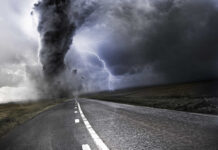
A rocket booster from China’s space program crashed into Earth in a southwest Chinese town over the weekend.
A viral video uploaded to Douyin, China’s version of TikTok, captures the massive booster rocket plummeting into a hillside covered with trees, close to what appears to be a residential neighborhood and a busy road.
The Chinese space agency said that the Long March 2C was successfully launched at 3 p.m. from Sichuan’s Xichang Satellite Launch Center. Scientists from France and China equipped the satellite with observational equipment.
Photos showing the damage inflicted by the superhot booster were uploaded to X. A structure’s open entryway is engulfed in flames, and rubble is spread across the ground. A smaller road is also partially blocked.
The village is located in the southwestern province of Guizhou.
A colorful gas cloud is seen rising from the fallen booster just after the crash. The Long March rocket uses the environmentally harmful fuel UDMH and nitrogen tetroxide, which can harm the environment.
In December, a video depicting the crash of a Long March 3B booster into a Guangxi village was published on China’s microblogging app Weibo. The collision produced a massive fireball.
Authorities in the area had already sent out a public notice warning people of potential falling debris in many places before the event. According to reports, no one was hurt.
In a separate event, the most prominent object to reenter Earth’s atmosphere uncontrollably since 1991 was a Long March 5B. Some of the debris, including a 40-foot pole, hit villages in the West African nation of Côte d’Ivoire.
NASA administrator Bill Nelson wrote on X that all countries involved in space exploration should adhere to established protocols and proactively exchange information to anticipate the potential risks of debris impact, particularly for larger spacecraft.





























